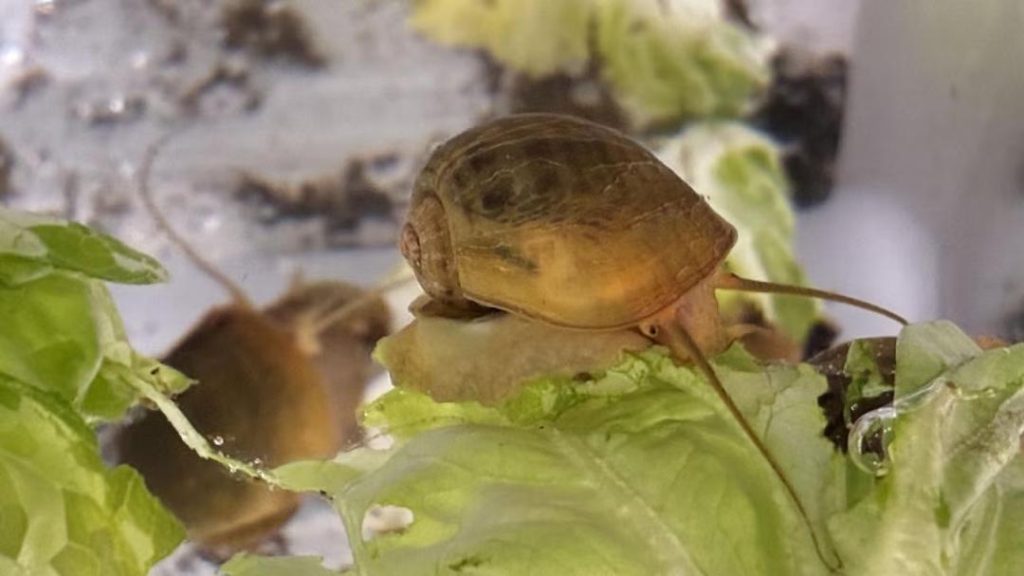
Snail that grows eyes back being studied in hope of helping humans
In a groundbreaking discovery, scientists are studying the freshwater apple snail, which has the remarkable ability to completely regrow its eyes, in the hopes of developing new treatments for human eye injuries. The snail’s incredible regenerative powers have fascinated researchers, who are working to uncover the genetic and molecular mechanisms behind this phenomenon. By understanding how the snail’s eyes grow back, scientists hope to one day restore damaged human vision.
The freshwater apple snail, also known as Pomacea diffusa, is a common species found in freshwater lakes and rivers around the world. While it may not be the most charismatic creature, its remarkable ability to regrow its eyes has made it a subject of intense scientific interest.
“When we discovered that the snail could regrow its eyes, we were amazed,” said Dr. Julia Kubota, a researcher at the University of California, Davis, who is leading the study. “We knew that we had to investigate this further to understand how it was possible.”
One of the key reasons why scientists are so interested in the snail’s ability to regrow its eyes is that human and snail eyes share many anatomical and genetic traits. In fact, the genes responsible for eye development in humans and snails are remarkably similar. This means that by studying the snail’s regenerative abilities, researchers may be able to gain valuable insights into how to restore human vision.
Using genome-editing techniques, such as CRISPR, researchers are investigating the genetic and molecular mechanisms behind the snail’s ability to regenerate its eye. They are examining the genes and proteins involved in eye development and regeneration, as well as the signaling pathways that trigger the regenerative response.
“The snail’s ability to regrow its eyes is likely to be related to its ability to regenerate its entire body,” said Dr. Kubota. “We’re studying the genetic and molecular mechanisms that allow the snail to regenerate its body, and how these mechanisms are specifically applied to eye regeneration.”
One of the key challenges facing researchers is understanding how the snail’s eye stem cells are able to differentiate into the different types of cells needed to form a new eye. In humans, eye stem cells are highly specialized and are difficult to manipulate. In contrast, the snail’s eye stem cells are much more versatile and can differentiate into a wide range of cell types.
“We’re trying to understand how the snail’s eye stem cells are able to differentiate into the different types of cells needed to form a new eye,” said Dr. Kubota. “If we can understand this process, we may be able to develop new techniques for manipulating human eye stem cells to restore damaged vision.”
In addition to its potential applications in human medicine, the study of the snail’s eye regenerative abilities may also have implications for our understanding of the evolution of eye development.
“The snail’s ability to regrow its eyes is likely to be an adaptation to its environment,” said Dr. Kubota. “By studying how the snail’s eyes have evolved to regenerate, we may be able to gain insights into the evolutionary history of eye development in humans and other animals.”
The study of the snail’s eye regenerative abilities is still in its early stages, but the potential implications are enormous. If researchers are able to unlock the secrets of the snail’s remarkable ability to regrow its eyes, it could lead to the development of new treatments for a range of eye injuries and diseases.
“We’re excited about the potential of this research to improve human health,” said Dr. Kubota. “By studying the snail’s remarkable ability to regrow its eyes, we may be able to develop new treatments that could restore damaged vision and improve the quality of life for millions of people around the world.”
Source:
https://www.ucdavis.edu/news/snails-eyes-grow-back-could-they-help-humans-do-same






